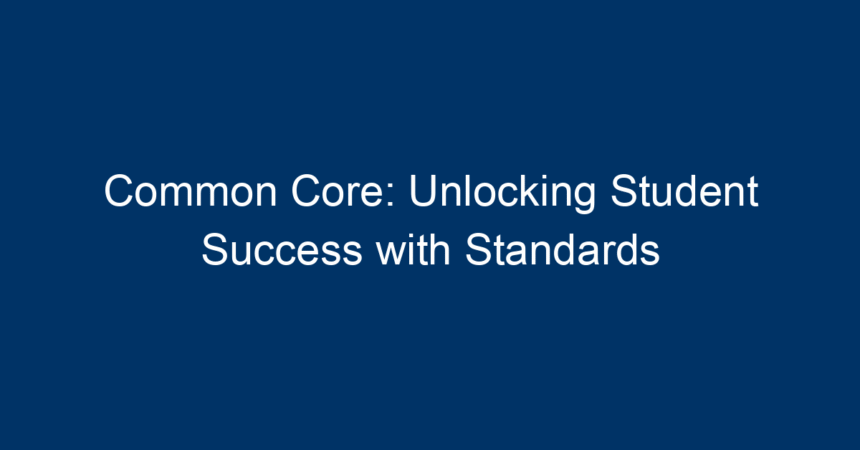In recent years, the term Common Core has become a cornerstone in discussions about education reform. Designed to provide a consistent framework for K-12 education across the United States, the Common Core State Standards (CCSS) aim to prepare students for college and the workforce by emphasizing critical thinking, problem-solving, and analytical skills. But what does this really mean for students, teachers, and parents? In this article, we’ll delve into the nitty-gritty of Common Core, its advantages, challenges, and actionable strategies to ensure it leads to student success.
Understanding Common Core
What is Common Core?
Common Core refers to a set of educational standards for mathematics and English language arts (ELA) designed to ensure that students graduating from high school are prepared for college and careers. Adopted by 41 states and the District of Columbia, these standards outline what students should know and be able to do at each grade level.
The Goals of Common Core
The primary objectives of the Common Core standards are to:
- Promote Uniformity: Ensuring all students, regardless of their location, receive a high-quality education.
- Focus on Skills: Emphasizing not just rote memorization, but deep understanding and application of knowledge.
- Prepare for Global Competitiveness: Equipping students with the skills they need to thrive in an increasingly globalized world.
The Benefits of Common Core
Increased Rigor in Education
One of the most significant advantages of the Common Core is its rigorous approach to education. The standards encourage higher-order thinking and push students to engage critically with materials. For example, instead of simply learning how to solve mathematical equations, students are taught to understand the underlying concepts and real-world applications of those equations.
Enhanced Collaboration Across States
By having a set of common standards, teachers can collaborate more effectively across state lines. This collaboration fosters the sharing of best practices, educational resources, and professional development opportunities, ultimately enhancing the quality of education nationwide.
Better Preparation for College and Careers
The Common Core standards are designed to focus on essential skills that colleges and employers seek, such as analytical writing, problem-solving, and effective communication. This preparation helps students transition more smoothly from high school to college or the workforce.
Challenges Associated with Common Core
Implementation Hurdles
While the intentions behind the Common Core are commendable, implementation can be a struggle. Teachers may require additional training to adapt to new teaching methods, and schools may need to invest in updated materials and technologies.
Resistance from Various Stakeholders
There is a range of opinions about Common Core, with some parents and educators expressing concerns about the effectiveness of the standards. Misunderstandings about their purpose can lead to significant resistance, complicating the implementation process.
Varying Levels of Resources
The effectiveness of Common Core hinges on equitable access to resources. Schools in affluent areas may have the tools and funding necessary to implement the standards effectively, while under-resourced schools may struggle.
Making Common Core Work for Students
Strategies for Educators
-
Professional Development: Teachers should engage in ongoing professional training to familiarize themselves with the Common Core standards and effective instructional methods tailored to them.
-
Collaboration and Sharing: Schools can foster a collaborative approach among educators, allowing them to share strategies, resources, and successful practices that support student learning.
- Utilizing Technology: Embracing technology can help educators create interactive lessons and assessments, which can make learning more engaging and effective in meeting the standards.
Tips for Parents
-
Stay Informed: Parents should actively educate themselves about the Common Core standards to better understand their child’s curriculum.
-
Engage in Learning: Encourage your child to share what they learn in school. Ask open-ended questions to stimulate critical thinking and deeper discussions about the subject matter.
- Advocate for Resources: Support initiatives that provide equitable resources for all schools, emphasizing the importance of equitable access to educational materials.
Student-Centric Approaches
-
Individual Learning Plans: Implementing personalized learning plans can help cater to each student’s unique abilities and learning pace, allowing them to meet Common Core standards effectively.
-
Real-World Applications: Incorporate real-world problems and projects into lessons. This will not only enhance understanding but also show students the practical applications of what they learn.
- Encouragement and Support: Create a supportive environment where students feel encouraged to ask questions and explore subjects in depth. A growth mindset can significantly enhance their learning experience.
Conclusion: Embracing the Future with Common Core
The Common Core standards represent a significant shift in the educational landscape, aiming to provide all students with the skills and knowledge they need for success in an increasingly complex world. Although there are challenges to implementation, the potential benefits for students’ academic and personal growth are substantial.
For students, teachers, and parents to fully realize the promise of Common Core, it is crucial to embrace a collaborative and informed approach. By consistently engaging with the standards, advocating for adequate resources, and fostering an environment of support and encouragement, we can unlock student success and prepare the next generation for a bright future.
As we navigate the complexities of educational reform, let’s keep in mind the primary goal: ensuring that every child has access to a quality education that empowers them to succeed. Together, through understanding and collaboration, we can help make the Common Core a powerful tool for educational success.




